
views
Transforming Your Thoughts
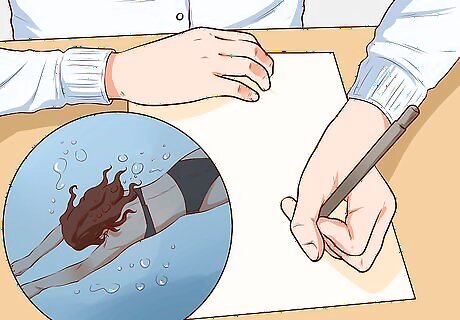
Listen to your internal dialogue. Some people develop a fear of swimming from a close-call drowning of oneself or another or after a boating accident. However this phobia developed, it is probably being made worse by the silent voice of your thoughts. Try this exercise - grab a pen and a notebook. Sit down and either think about swimming, sit in a place where water is visible, or look at picture of water or people swimming. Listen to your self-talk. What kinds of things are you saying to yourself about water and swimming. Examples may include "That's dangerous" or "They are crazy to go out there".

Restructure your thoughts about swimming. Having a fear of swimming means you also have a negative or irrational viewpoint of swimming. In order to overcome this fear, you must change these thoughts. Once you have taken the time to listen to your thoughts, you may notice how they are not serving you. An effective way to cognitively restructure such thoughts is by examining the evidence for or against the thought. Let's take the thought "That's dangerous" in reference to swimming. How much evidence is available that confirms this statement? Maybe you had a past incident in which swimming or water was, indeed, dangerous. However, that incident may have been one among few. In general, many people who are able to swim enjoy water and find the activity quite relaxing. Can you think of times when people went swimming and nothing disastrous or dangerous happened? Switch your statement around to take this into consideration. You might say "Swimming can be dangerous, but it is safe if you follow best practices and have a lifeguard present."

Shift perspectives. Maybe your whole frame of thinking in regards to swimming is from a negative point of view. Change your point of view by searching for ways to view swimming in a positive light. For example, in the summertime, swimming is a wonderful activity to play and keep cool. Swimming is a terrific way to get exercise. You might also consider that the act of swimming allows humans to see all the wonders beneath the sea, such as fish, turtles, and coral.

Know you're not alone. Whether you are a child, teen, or adult, you should not feel embarrassed about your fear of swimming. Aquaphobia is a very real and debilitating concern, but many people go on to overcome this phobia and become proficient swimmers.
Getting Comfortable with Water

Try calming yourself with deep breathing. Controlling anxiety associated with swimming is a key step to preventing drowning. Aim to reduce your stress about swimming gradually. First simply learn to practice deep breathing. Then, depending on the severity of your fear of pools or bodies of water, you can progress to doing this practice while looking at picture of water or looking at a pool. Finally, once you're more comfortable, get in the shallow end of a pool and only focus on taking relaxing breaths. To practice deep breathing, find a comfortable spot to sit, such as a chair or cushion. Relax your shoulders and exhale heavily. Now, inhale air through your nose for 4 counts. Hold it for 1 or 2 counts, then slowly release the air through your mouth for 4 more counts. Take a brief pause and then repeat the exercise for approximately 5 minutes, or until you feel relaxed. To ensure you are breathing correctly, place one hand on your chest and one on your abdomen. You should notice the hand on your abdomen expanding and then collapsing with each breath. The hand on your chest should move only a little.

Practice visualization. Visualization or positive imagery is frequently used to diminish anxiety and overcome fears. Use this practice to imagine yourself swimming. There are many ways to practice visualization. In this method, the goal is envision yourself comfortably and confidently getting into a pool. Be warned, if you are frightened by even the thought of swimming, you may need to seek the assistance of a mental health therapist to help you. Don't practice visualization on your own if you are not yet comfortable with the idea of being near water. Lie on a sofa or bed in a relaxed position with your arms resting at your sides. Start by taking a few deep, cleansing breaths. If at any point, you notice your anxiety increasing, stop the visualization process and continue to take deep, relaxing breaths. Think of yourself sitting in a chair beside a pool. Look around you. You see a life guard who is there to protect you. You feel warm and safe due to his presence. You hear the laughter of people on the far end as they play around in the waves. You smell the chlorine. Soak in all of these sensations. Now, stand up. Feel the concrete beneath your feet. Hear the gentle crashing sound of the waves as you walk closer to the shallow end of the pool. Stand at the edge. Notice how the other swimmers are happy and confident. Channel their energy. Believe that you, too, can feel happy and confident about swimming. Dip one of your feet in the water. Notice the relative warmth (or coolness) of the water. Listen to the splashing sound your foot makes. Take a seat on the edge and lower both feet into the water. Sit there just taking in the feeling of your feet being in the water. Use the ladder to step down into the water. Feel the cold shock of the steel as your fingers move along the rails. Notice how the water feels against your skin as it climbs to your waist. Move up against a wall. You don't have to do anything else, just once again breathe deeply and notice how confident and relaxed you feel in the water.

Find a skilled partner. One way to feel more comfortable in water is to ask a friend with strong swimming skills to assist you with these relaxation activities. Your friend can sit with you as you practice your breathing. Or, hold your hand as you walk through the visualization exercise. Having a physical and emotional support system can help you feel less stressed about swimming since you are not doing the activity on your own. If you should need it, a helping hand is nearby.
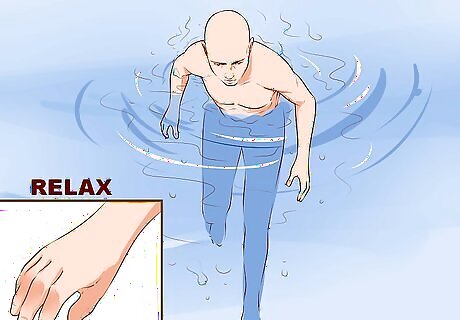
Remember the buoyancy factor. Feeling weightless in water is often a contributor to why some people fear swimming. The feeling of being in water is so different than being on the ground. This happen because gravity behaves in reverse in water. This weightless feeling, commonly known as buoyancy, helps you naturally float in water. Once you recognize that if you relax your limbs, you will automatically rise to the surface, you can move past fears of sinking.
Building Confidence and Skills
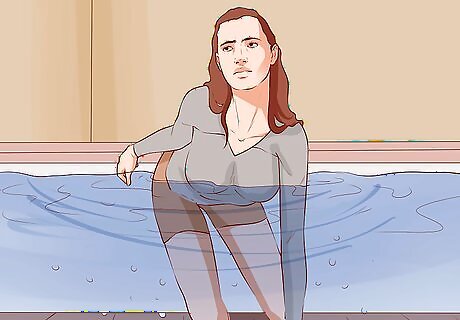
Start small, in shallow water. The best way to overcome your fear of swimming is to take baby steps. You may start by challenging yourself to sit near the pool. After you become acclimated to being near water, progress to sitting on the edge of the pool with your legs in the water. Then, you might simply stand in the shallow portion of the pool and get used to how that feels.
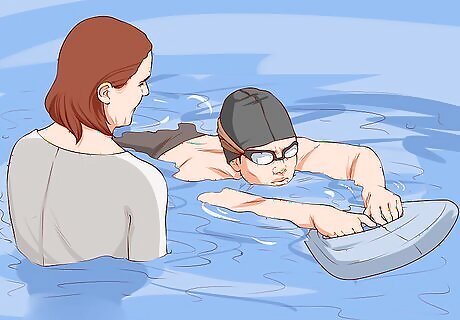
Take professional swimming lessons. Working with a skilled swim coach is the most effective way to not only learn how to swim, but also feel more confident in the water. A coach will be aware of your biggest concerns, and take you slowly through the process until you build up the confidence and skills necessary to swim.
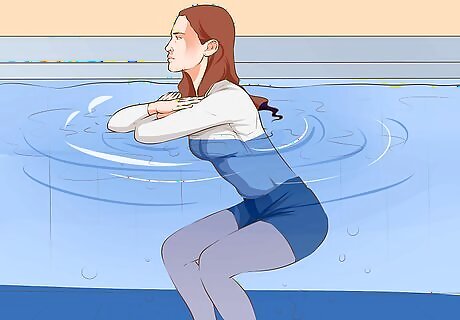
Build your core strength. Swimming requires the activation of your core muscles. To improve your skills and feel more strong and confident in the water, exercise to strengthen your core. Any sort of physical activity can improve your strength and endurance for swimming. Try planks, squats, and lunges for optimal core strength. Besides making you stronger for swimming, core exercises can improve your posture and reduce your risk of falls.
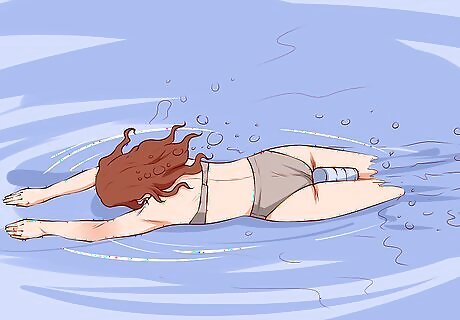
Graduate to open or deeper water only when you're ready. Your ultimate goal may be to swim laps around the pool or join your friends in the ocean on a beach vacation. It's important to set goals, of course, but, it's also significant that you get comfortable with swimming on your own pace.

Celebrate your progress. If you started out being completely afraid of getting in the pool, and you are now splashing around the shallow end, give yourself a pat on the back. Celebrating even the smallest victories builds confidence in your abilities.




















Comments
0 comment